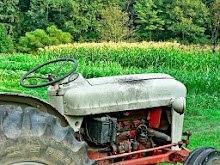Since getting the book, I have made butter, whey, cream cheese, soaked blueberry muffins, and Kimchi. I have been amazed at the ease and simplicity with which these formerly formidable soaked and fermented foods came together.
This afternoon, I made Korean Sauerkraut, or 'Kimchi' as it is called there. I have never made anything like this, and this being my first foray into the world of fermented vegetables, I thought it necessary to chronicle my experience here.
For a little background, here is an excerpt from Nourishing Traditions (by Sally Fallon) about fermented fruits and vegetables-
"The ancient Greeks understood that important chemical changes took place during this type of fermentation. Their name for this change was "alchemy." Like the fermentation of dairy products, preservation of vegetables and fruits by the process of lacto-fermentation has numerous advantages beyond those of simple preservation. The proliferation of lactobacilli in fermented vegetables enhances their digestibility and increases vitamin levels. These beneficial organisms produce numerous helpful enzymes as well as antibiotic and anticarcinogenic substances. Their main by-product, lactic acid, not only keeps vegetables and fruits in a state of perfect preservation but also promotes the growth of healthy flora throughout the intestine. Other alchemical by-products include hydrogen peroxide and small amounts of benzoic acid."
Does this give me license to call myself an alchemist? I think I shall.
"Lacto-fermented condiments are easy to make. Fruits and vegetables are first washed and cut up, mixed with salt and herbs or spices and then pounded briefly to release juices. They are then pressed into an air tight container. Salt inhibits putrefying bacteria for several days until enough lactic acid is produced to preserve the vegetables for many months. The amount of salt can be reduced or even eliminated if whey is added to the pickling solution. Rich in lactic acid and lactic-acid-producing bacteria, whey acts as an inoculant, reducing the time needed for sufficient lactic acid to be produced to ensure preservation. Use of whey will result in consistently successful pickling; it is essential for pickling fruits. During the first few days of fermentation, the vegetables are kept at room temperature; afterwards, they must be placed in a cool, dark place for long-term preservation."
(all italicized text from Nourishing Traditions by Sally Fallon)
The ready-to-ferment product!
Korean Sauerkraut, or 'Kimchi'
(from Nourishing Traditions)
makes 2 quarts
1 head Napa cabbage, cored and shredded
1 bunch of green onions, chopped
1 cup carrots, grated
1/2 cup daikon radish, grated
1 tablespoon fresh grated ginger
3 cloves garlic, peeled and minced
1/2 teaspoon dried chili flakes
1 tablespoon sea salt
4 tablespoons whey* (or use additional 1 T salt instead)
Place vegetables, ginger, red chili flakes, salt and whey in a bowl and pound it with a wooden pounder or a meat hammer to release juices. Place them in two quart sized glass jars and press down firmly until all the juices come up to the top and cover the vegetables. The top of the vegetables should be at least an inch from the top of the jar. Cover tightly and keep at room temperature for about 3 days at which time you can put it in the fridge or cold storage.
Or, you can store the kimchi in your dungeon if you have one handy.
What, you don't have a dungeon?! Oh, how much you miss.....
While I was making this recipe, I saw that it called for using a meat hammer or wooden pounder to help the mixture get juicy. I had neither on hand, and so I went ahead and used the remnant of the daikon radish (which was at least 20'' long and 3'' in diameter) to pound it with. Yes, I just said to mash your vegetables with a vegetable. But, it works!
Well, there are some who do not appreciate my efforts.....
 but hey, that leaves more for the rest of us!
but hey, that leaves more for the rest of us!Stay tuned for part 2, in which I shall attempt a %100 Whole Wheat yeast-less sourdough bread.










